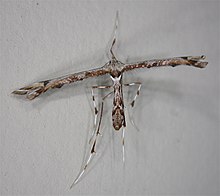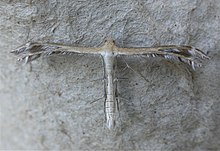Pterophoridae
| Pterophoridae Temporal range:
| |
|---|---|

| |
| Pterophorus pentadactyla | |
| Scientific classification | |
| Domain: | Eukaryota |
| Kingdom: | Animalia |
| Phylum: | Arthropoda |
| Class: | Insecta |
| Order: | Lepidoptera |
| Superfamily: | Pterophoroidea |
| Family: | Pterophoridae Zeller,1841 |
| Type species | |
| Pterophorus pentadactyla | |
| Subfamilies | |
| |
| Diversity | |
| >90 genera >1,000 species | |
ThePterophoridaeorplume mothsare afamilyofLepidopterawith unusually modified wings, giving them the shape of a narrow winged airplane. Though they belong to theApoditrysialike the largermothsand thebutterflies,unlike these they are tiny and were formerly included among the assemblage called "microlepidoptera".
Description and ecology
[edit]
The forewings of plume moths usually consist of two curved spars with more or less bedraggled bristles trailing behind. This resembles the closely relatedAlucitidae(many-plumed moths) at first glance, but the latter have a greater number of symmetrical plumes. The hindwings are similarly constructed, but have three spars. This unorthodox structure does not prevent flight.[1]A fewgenerahave normallepidopteranwings.
The usual resting posture is with the wings extended laterally and narrowly rolled up. Often they resemble a piece of dried grass, and may pass unnoticed by potential predators even when resting in exposed situations in daylight. Some species have larvae which are stem- or root-borers while others are leaf-browsers.
Economically important pterophorids include theartichoke plume moth(Platyptilia carduidactyla), anartichoke(Cynara cardunculus) pest inCalifornia,while thegeranium plume moth(Platyptilia pica)[2]and thesnapdragon plume moth(Stenoptilodes antirrhina) can cause damage to theornamental plantsgarden geranium (Pelargonium x hortorum) and common snapdragon (Antirrhinum majus), respectively. Other plume moths have been used asbiological control agentsagainst invasive plant species –Lantanophaga pusillidactylaagainst West Indian lantana (Lantana camara),Oidaematophorus beneficusagainst mistflower (Ageratina riparia),Hellinsia balanotesagainst groundsel bush (Baccharis halimifolia),[3]andWheeleria spilodactylusagainst horehound (Marrubium vulgare).[4]
Evolution
[edit]A fossil species from the extant genusMerrifieldiais known from theOligoceneof France.[5][6]
Taxonomy
[edit]The small group of moths in the genusAgdistopishas often been treated as a subfamily Macropiratinae within the Pterophoridae, but recent research indicates that this group should be considered a separate family. Around 1580 accepted species are currently accepted for the Pterophoridae.[7]
The family is divided into the followingsubfamilies,tribesandgenera,[8]somespeciesare also listed:
SubfamilyAgdistinae
- GenusAgdistisHübner, 1825
SubfamilyOchyroticinae
Subfamily DeuterocopinaeGielis, 1993
- GenusDeuterocopus
- GenusHeptaloba
- GenusHexadactilia
- GenusLeptodeuterocopus
SubfamilyPterophorinaeZeller, 1841
- TribeTetraschalini
- GenusTetraschalis
- GenusTitanoptilus
- GenusWalsinghamiella
- TribePlatyptiliini
- GenusAmblyptiliaHübner, 1825
- GenusAnstenoptilia
- GenusAsiaephorus
- GenusBigotilia
- GenusBipunctiphorus
- GenusBuszkoiana
- GenusCnaemidophorusWallengren, 1862
- GenusCrocydoscelus
- GenusFletcherella
- GenusGillmeriaTutt, 1905
- GenusInferuncus
- GenusKoremaguia
- GenusLantanophagaZimmermann, 1958
- GenusLeesi
- GenusLioptilodes
- GenusMelanoptilia
- GenusMichaelophorus
- GenusNippoptilia
- GenusParaamblyptilia
- GenusParaplatyptilia
- GenusPlatyptiliaHübner, 1825

Platyptilia celidotus
(Pterophorinae:Platyptiliini)
Platyptilia falcatalis
(Pterophorinae:Platyptiliini) - GenusPlatyptiliodes
- GenusPostplatyptilia
- GenusQuadriptilia
- GenusSinpunctiptilia
- GenusSochchora
- GenusSphenarches
- GenusStenoptiliaHübner, 1825
- GenusStenoptilodesZimmermann, 1958
- Stenoptilodes antirrhina– snapdragon plume moth
- GenusStockophorus
- GenusUroloba
- GenusVietteilus
- GenusXyroptila
- TribeMarasmarchini
- GenusArcoptilia
- GenusExelastis
- GenusFuscoptilia
- GenusMarasmarcha
- GenusParafuscoptilia
- TribeOxyptilini
- GenusApoxyptilusAlipanah et al., 2010
- GenusBuckleriaTutt, 1905
- GenusCapperia
- GenusCrombrugghia

Stenodacma wahlbergi(Pterophorinae:Oxyptilini) - GenusDejongia
- GenusEucapperia
- GenusGeina
- GenusIntercapperia
- GenusMegalorhipidaAmsel, 1935
- GenusOxyptilus
- GenusParacapperia
- GenusPrichotilusRose and Pooni, 2003
- GenusProcapperia
- GenusPseudoxyptilusAlipanah et al., 2010
- GenusStangeiaTutt, 1905
- GenusStenodacma
- GenusTomotilus
- GenusTrichoptilus
- TribeOidaematophorini
- GenusAdaina
- GenusCrassuncus
- GenusEmmelinaTutt, 1905
- GenusGypsochares
- GenusHellinsiaTutt, 1905
- GenusHelpaphorus
- GenusKarachia
- GenusOidaematophorusWallengren, 1862
- GenusPicardia
- GenusPselnophorusWallengren, 1881
- GenusPuerphorus
- GenusSetosipennula
- TribePterophorini
- GenusCalyciphora
- GenusCosmoclostis
- GenusDiacrotricha
- GenusImbophorus
- GenusMerrifieldia
- GenusOirata
- GenusPatagonophorus
- GenusPorrittia
- GenusPterophorus
- Pterophorus pentadactyla– white plume moth
- GenusSeptuaginta
- GenusSingularia
- GenusTabulaephorus
- GenusWheeleriaTutt, 1905
Footnotes
[edit]- ^Haynes, K.F. & Birch, M.C. (1984)
- ^MDA (1980)
- ^Palmer, W.A. & Haseler, W.H. (1992)
- ^Baker, J. (2002)
- ^L. Bigot, A. Nel, and J. Nel. 1986. Description de la première espèce fossile connue de Ptérophore (Lepidoptera Pterophoridae).Alexanor14:283-288
- ^SOHN, JAE-CHEON; LABANDEIRA, CONRAD; DAVIS, DONALD; MITTER, CHARLES (2012-04-30)."An annotated catalog of fossil and subfossil Lepidoptera (Insecta: Holometabola) of the world".Zootaxa.3286(1): 1.doi:10.11646/zootaxa.3286.1.1.ISSN1175-5334.
- ^Hobern, D. (2024)
- ^Gielis, Cees (2000-05-31)."Division of the Pterophoridae into Tribes (Lepidoptera)"(PDF).Quadrifina.3:57–60 – via ZOBODAT.
References
[edit]- Baker, J.(2002): Factors affecting the establishment of a classical biological control agent, the horehound plume moth (Wheeleria spilodactylus) in South Australia. (A thesis submitted for the degree of Doctor of Philosophy in the Department of Applied and Molecular Ecology, Adelaide University, Australia)PDF fulltext
- Hobern, D.(2024): Catalogue of World PterophoroideaWebsite
- Michigan Department of Agriculture(MDA)(1980): Geranium Plume Moth Quarantine.PDF fulltext
- Palmer, W.A & Haseler, W.H.(1992): Foodplant Specificity and Biology of Oidaematophorus balanotes (Pterophoridae): A North American Moth Introduced into Australia for the Control of Baccharis halimifolia (Journal of the Lepidopterists' Society 46(3), 1992: 195–202).PDF fulltext[permanent dead link]
- Haynes, K.F. & Birch, M.C.(1984): Mate-locating and courtship behaviors of the artichoke plume moth, Platyptilia carduidactyla (Lepidoptera: Pterophoridae) (Environmental Entomology 13.2 1984: 399–408).https://academic.oup.com/ee/article-abstract/13/2/399/2393151]
External links
[edit]- British Insects: the Families of LepidopteraArchived2020-02-14 at theWayback Machine
- http://www.plumemoth.com/D.L. Matthews, PhD. Florida Museum
- A slow-motion video of a flying plume moth, taken by three fast camerashttps://www.beatus-lab.org/fun-stuff

